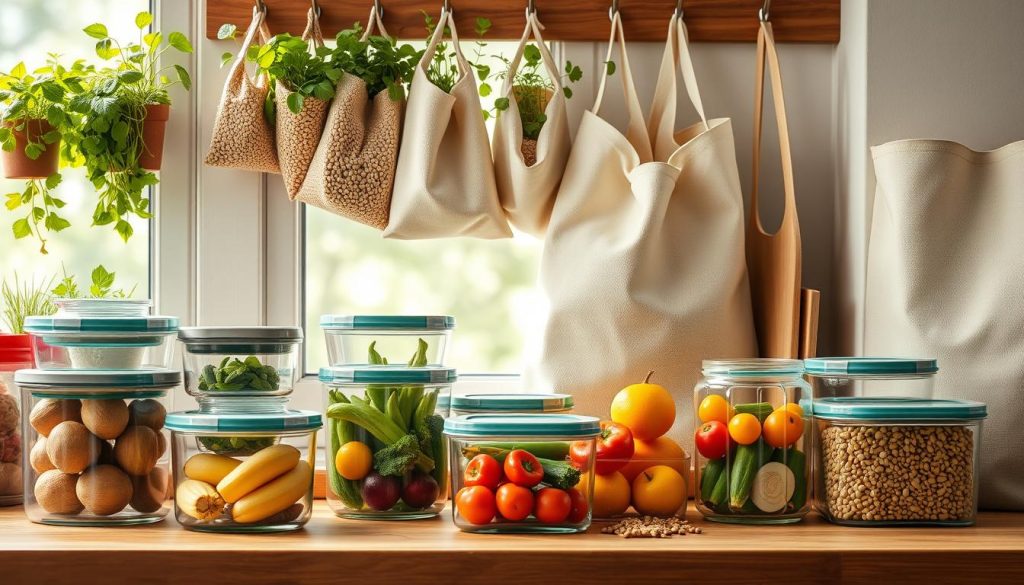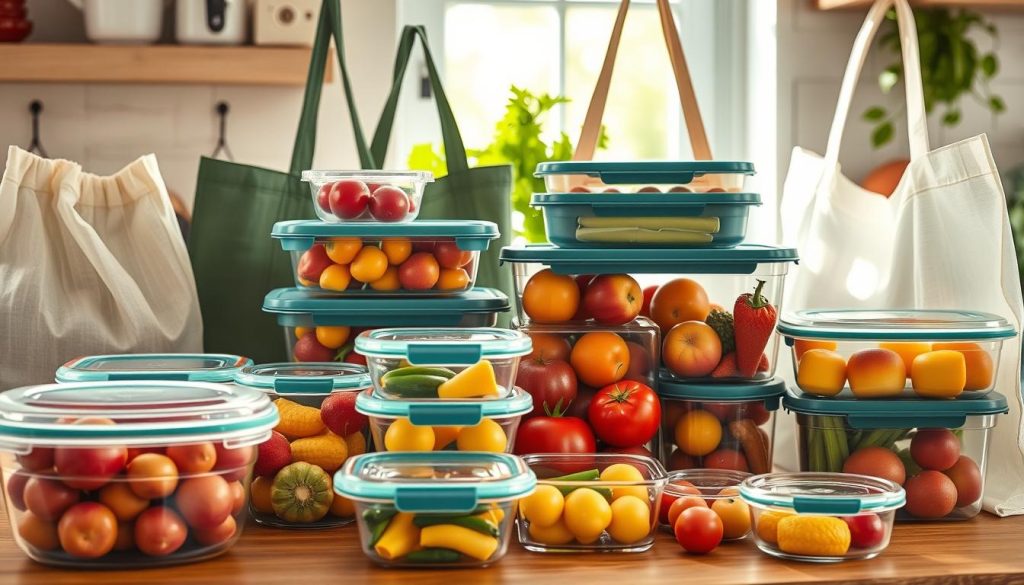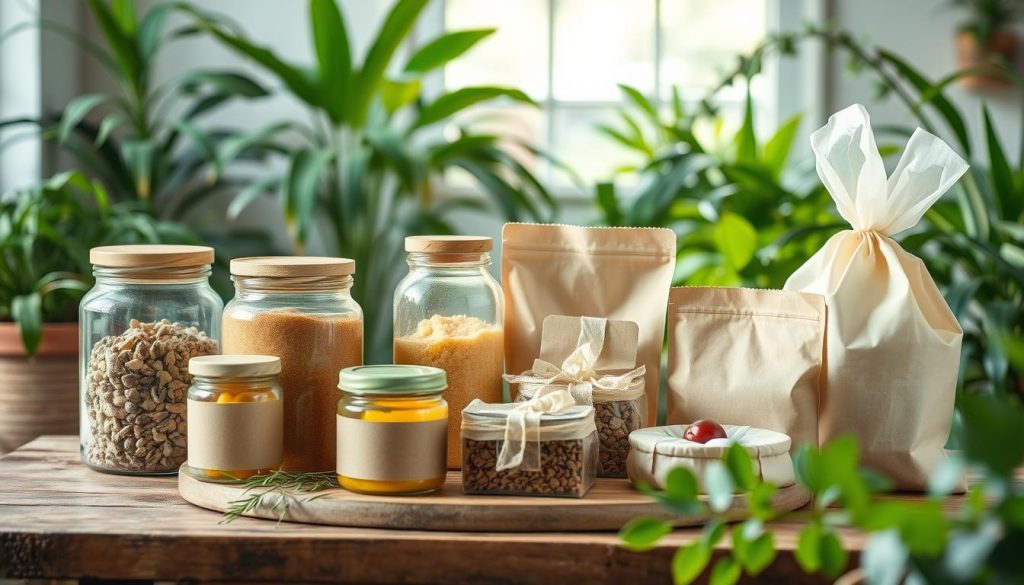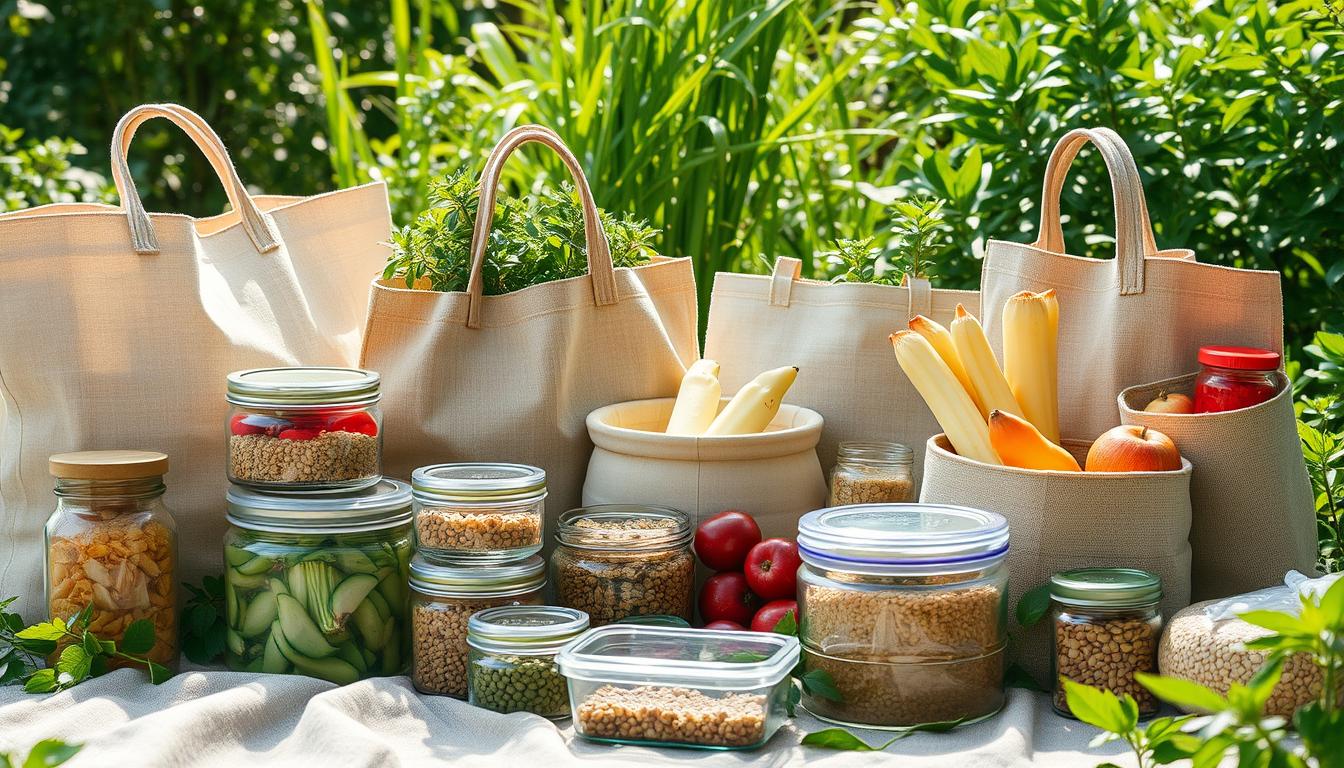I found a game-changer for a greener lifestyle: reusable containers and bags. These alternatives have changed how I shop and store food. They help me reduce waste and live more sustainably.
Switching to reusable items has opened my eyes. I’m using less single-use plastics and saving money. Stylish glass containers and strong cloth bags are now key parts of my day. Let’s dive into eco-friendly packaging and see how it can help our planet.
The Environmental Impact of Single-Use Plastics
Single-use plastics are a big problem for our planet. We must find plastic alternatives and live a zero waste lifestyle. Let’s look at how our throwaway culture harms the environment.
Pollution in Oceans and Landfills
Plastic waste fills our oceans and landfills. Every year, millions of tons of plastic pollute our waters, creating huge garbage patches. On land, landfills are overwhelmed by plastic waste. This pollution damages ecosystems and takes centuries to break down.
Carbon Footprint of Plastic Production
Plastic production is a big source of greenhouse gas emissions. From getting raw materials to making plastics, lots of carbon dioxide is released. Choosing eco-friendly alternatives can help reduce our carbon footprint and fight climate change.
Wildlife Hazards Caused by Plastic Waste
Plastic waste is a huge threat to wildlife. Marine animals often think plastic is food, leading to starvation or suffocation. On land, animals get tangled in plastic, causing harm or death. Microplastics from plastic breakdown contaminate food chains, affecting even the smallest creatures.
To solve these problems, I’m dedicated to finding plastic alternatives and living a zero waste lifestyle. By changing our daily habits, we can make a big impact on protecting our environment.
Benefits of Switching to Reusable Containers and Bags

Switching to reusable containers and bags has changed my life. It’s made my zero waste lifestyle easier. I’ve cut down on waste and saved money.
Now, my trash cans don’t overflow. I don’t feel bad about throwing things away. My kitchen is filled with stylish, eco-friendly items. They keep my food fresh for longer.
It’s also saved me a lot of money. The first cost of good reusables might seem high. But, I hardly spend anything on disposable items anymore. It’s good for my wallet and the planet.
- Reduced waste generation
- Lower carbon footprint
- Significant cost savings over time
- Extended food freshness
- Decreased reliance on single-use plastics
Choosing reusable containers and bags is a big step towards a greener future. It’s rewarding to see how my choices help the environment. If you’re thinking about making the switch, do it. It’s a small change with a big difference.
Types of Reusable Containers for Food Storage

Reusable containers and bags have changed the game for food storage. They cut down on waste and keep food fresh. Let’s look at some top plastic alternatives for my kitchen.
Glass Containers: Pros and Cons
Glass containers are my top choice for leftovers. They’re tough, don’t hold smells, and can go in the microwave. But, they’re heavy and can break if dropped.
Stainless Steel Options
Stainless steel containers are perfect for lunches on the go. They’re light, hard to break, and keep food at the right temperature. The only issue is you can’t see inside without opening it.
Silicone Containers: Flexibility and Durability
Silicone containers are a new favorite of mine. They’re flexible, great for tight spaces, and can handle heat. But, they can hold strong smells if not cleaned right.
| Container Type | Durability | Weight | Odor Resistance |
|---|---|---|---|
| Glass | High | Heavy | Excellent |
| Stainless Steel | Very High | Light | Good |
| Silicone | High | Very Light | Fair |
Using these reusable containers daily has cut down my single-use plastic use. It’s a small step that makes a big environmental impact.
Eco-Friendly Reusable Bags for Shopping
I love using reusable produce bags when I go grocery shopping. These bags are made from sustainable materials and come in many styles. They’re perfect for different shopping needs and can replace single-use plastics.
Cloth bags are my favorite for general shopping. They’re made from organic cotton and are easy to wash. I use them for clothes, books, and more.
Mesh bags are great for fruits and vegetables. They’re lightweight and let air in, keeping produce fresh. Plus, they make it easy for cashiers to see what’s inside.
Canvas bags are perfect for heavy items. They’re sturdy and can hold a lot of weight. This makes them ideal for canned goods or bulky items.
| Bag Type | Best For | Material | Durability |
|---|---|---|---|
| Cloth | General shopping | Organic cotton | High |
| Mesh | Produce | Recycled polyester | Medium |
| Canvas | Heavy items | Hemp or cotton | Very high |
Using these reusable bags has greatly reduced my plastic waste. They’re not only good for the environment but also practical and comfortable. Switching to reusable bags is a simple way to live more sustainably.
Sustainable Materials Used in Reusable Products

I’ve found that sustainable materials are key in eco-friendly packaging and plastic alternatives. Let’s look at some popular options that are changing how we view reusable products.
Bamboo: A Renewable Resource
Bamboo is a fast-growing plant that’s making waves in sustainable materials. I love bamboo products because they’re strong, naturally antibacterial, and can break down. Bamboo is great for everyday items like toothbrushes and cutting boards.
Organic Cotton and Its Benefits
Organic cotton is a standout in fabric-based reusables. I use organic cotton bags for grocery shopping and they’re amazing. They’re strong and soft, and grown without harmful pesticides. This makes them better for the planet and our health.
Recycled Plastics: Giving Waste a New Life
Recycled plastics are a creative way to make new products from old waste. I’ve seen water bottles and outdoor furniture made from recycled plastics. This method cuts down on landfill waste and lowers the need for new plastic.
| Material | Durability | Biodegradability | Common Uses |
|---|---|---|---|
| Bamboo | High | Yes | Utensils, containers, textiles |
| Organic Cotton | Medium | Yes | Bags, clothing, home goods |
| Recycled Plastics | High | No | Bottles, packaging, furniture |
By picking products made from these sustainable materials, I’m lowering my environmental impact. I’m also supporting eco-friendly industries. It’s thrilling to see these solutions help create a greener future.
How to Incorporate Reusables into Your Daily Routine
Starting a zero waste lifestyle is all about small, consistent changes. By using reusable containers and bags daily, I’ve become more eco-friendly. And I haven’t lost any convenience.
For my work lunches, I use stainless steel containers. They’re tough, simple to clean, and keep my food fresh. I also carry bamboo utensils to avoid plastic waste.
At the grocery store, I always bring my reusable bags. I have a few in my car and a small one in my purse. This way, I’m always ready. For fruits and veggies, I use mesh bags instead of plastic ones.
- Replace disposable water bottles with a reusable one
- Use cloth napkins instead of paper
- Bring your own coffee mug to cafes
- Store leftovers in glass containers
Traveling can be tricky, but I’ve found ways to handle it. I carry a collapsible silicone container and a foldable shopping bag. They’re small but useful for any unexpected needs.
These simple changes have greatly reduced my waste. It’s incredible how these small steps can lead to a more sustainable life.
Cleaning and Maintaining Your Reusable Items
I love using reusable containers and bags. But, keeping them clean is essential. Let’s look at how to care for these items so they last and stay clean.
Proper Washing Techniques
Right after use, I rinse my reusable containers. Then, I wash them with hot, soapy water. For stubborn stains, I soak them first and then scrub.
Most containers can go in the dishwasher, making cleaning easy.
Natural Cleaning Solutions
I choose natural cleaners for my eco-friendly items. Vinegar and water work well for glass containers. For stainless steel, baking soda paste is my go-to.
These methods keep my items clean without using harsh chemicals.
Extending the Lifespan of Your Reusables
To make my reusables last, I avoid extreme temperatures. I never put hot food in cold containers or vice versa. For bags, I switch up which one I use to prevent wear.
It’s important to store them properly. I keep them dry and out of direct sunlight.
| Material | Cleaning Method | Maintenance Tip |
|---|---|---|
| Glass | Vinegar solution | Avoid thermal shock |
| Stainless Steel | Baking soda paste | Dry thoroughly |
| Silicone | Dishwasher safe | Store flat |
By following these tips, I keep my reusable containers and bags in great condition. This care not only makes them last longer but also supports my eco-friendly lifestyle.
Cost Comparison: Disposables vs. Reusables
I’ve adopted a zero waste lifestyle and found it saves money. Switching to reusable containers and bags is a smart move. Let’s look at how reusables can cut costs over time.
At first, I was unsure about the cost of reusables. But, after doing the math, I saw the savings. Here’s a comparison of costs:
| Item | Disposable (Annual Cost) | Reusable (5-Year Cost) |
|---|---|---|
| Water Bottles | $365 | $50 |
| Grocery Bags | $50 | $20 |
| Food Storage Containers | $120 | $80 |
| Coffee Cups | $300 | $30 |
| Total | $835 | $180 |
The savings are clear. Reusables have cut my costs by over 75% in five years. That’s a total of $4,000 saved! Plus, I’m helping the environment.
Keep in mind, these numbers are estimates. Your savings might differ based on your habits. But, switching to reusables is good for your wallet and the planet!
Innovative Designs in Reusable Containers and Bags
I’m always amazed by the creative solutions in eco-friendly packaging. Designers are making reusable containers and bags stylish and practical. Some containers have built-in dividers for meal prep or storing leftovers.
These smart designs help reduce food waste and make packing lunches easy. It’s a win-win for both the planet and our daily lives.
Sustainable materials are key in these innovations. I’ve seen bags made from algae-based fabrics that break down quickly if thrown away. Containers made from rice husks or coconut shells also get a second chance.
Tech is also changing the game for reusable containers and bags. Some products have QR codes for recycling info or recipes. There are even smart containers that track food freshness and send alerts to your phone.
It’s exciting to see how these advancements make eco-friendly living easier and more appealing. They’re making a big difference in our daily lives.
